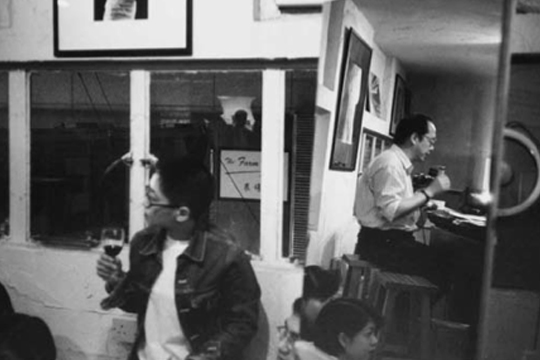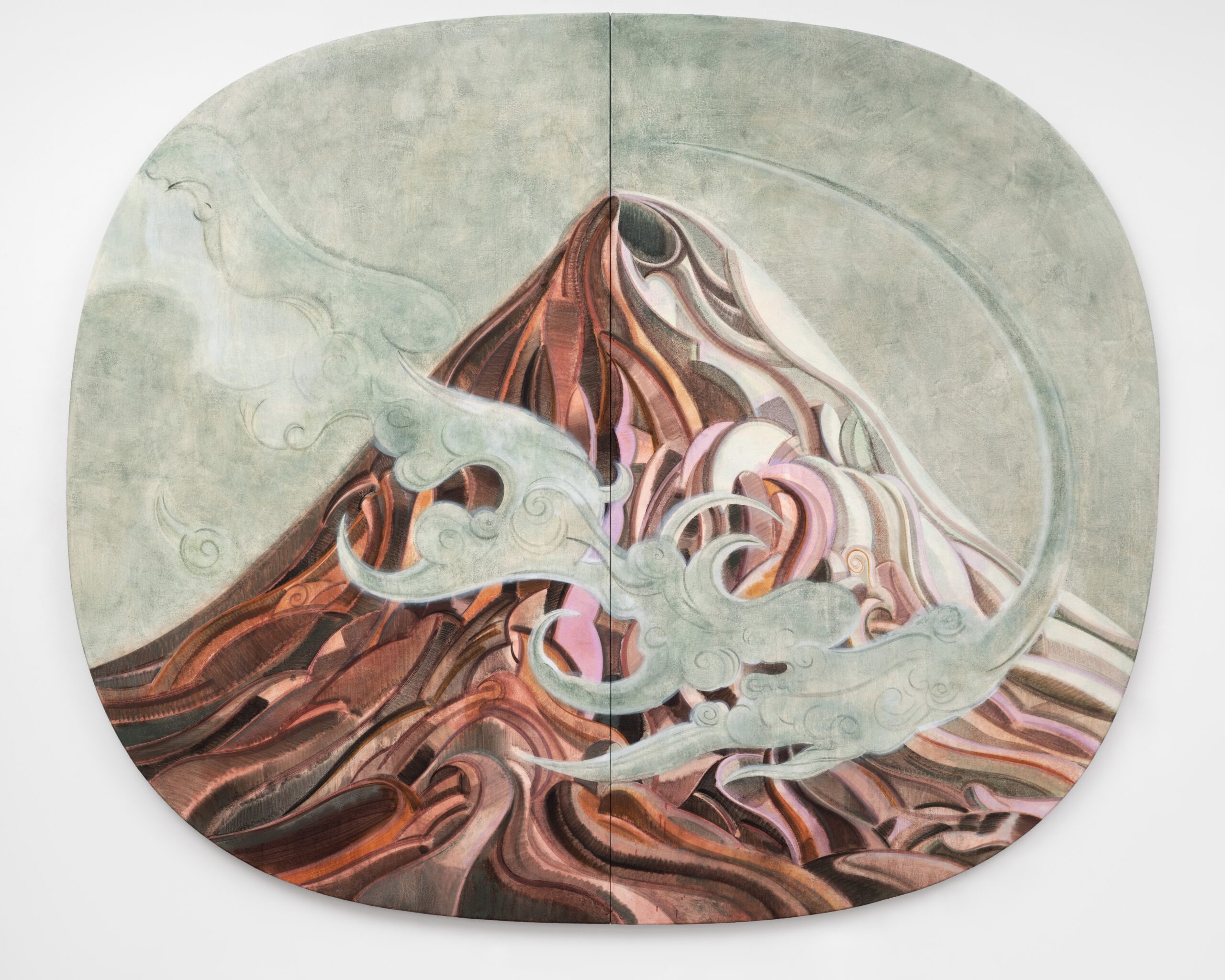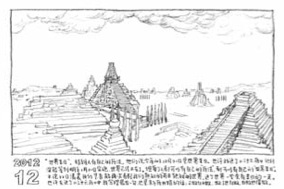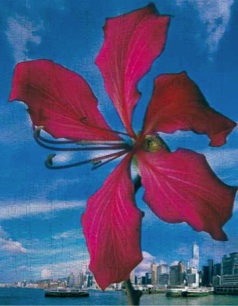HONG KONG TIME
| 2013年05月23日 | 发表于 LEAP 20

SONG DONG’S 36 Calendars installation offers, through its participatory, dialogic dimension involving more than 400 members of the Hong Kong public, a way to examine local Hong Kong perceptions of history, and also perhaps highlights the issue of the difference that may exist between Mainland and Hong Kong senses of history. Calendars are a traditional tool for dealing with the passage of time, used to prepare for the future (usually on an annual basis) as well as retained to provide a diary-like personal trace of past events. Their grid-like neutrality and concern for providing equal emphasis on each individual day can give them a degree of distance from the more synoptic vision of time which is found in the history textbook, and which services national ideology since nations are the characteristic subjects of historical narratives. Dividing time up into distinct 24-hour periods is arbitrary in one sense— indeed, time is by its nature an abstraction imposed on a concrete reality which exists always in the present tense— but the breaking down of time into discrete units opens up a space where memory can come into play and start to contest the closures of more joined-up historical narratives, particularly those promoted by the state. Since most of the local collaborators on the 36 Calendars project will not have been professional historians, and since the time period involved (the previous 36 years) is within the lifetime of a great many local residents, it is likely that personal memory has played a particular role in guiding their interventions (to the extent that those interventions were historically motivated in the first place— Song Dong’s original work is certainly historical in nature, but some collaborators may have responded more to the calendars’ deliberate semblance with children’s coloring books, and have had other, non-historical, motivations in mind for their contributions).
Memory as a tool to critique written history has been particularly valuable in Hong Kong, since as a city rather than a country it doesn’t usually get to be the bearer of its own independent historical narrative. Historical grand narratives belong to nations, and memory serves to help proliferate micro-narratives which can counter them, allowing local meanings and identities to flourish. Where the history of Hong Kong has been referenced as part of a Chinese national story it has been used to construct a narrative of colonial dispossession which can serve to provide background and emphasis to a feel-good nationalistic story of post-1997 territorial reunification. In such a story Hong Kong and its residents become an object of a history addressed to other audiences with the purpose of producing consent to one-party rule, not the autonomous subject of their own narrative. Chinese national stories have tended to be future-oriented, and even in a sense I would argue amnesic, closed off against a true examination of the past (The Great Leap Forward and the Cultural Revolution are still not matters that can be openly debated in China, let alone the events of June 1989).
To find examples of the amnesic nature of Chinese national narratives one can turn to Hong Kong’s built environment, which in the late colonial era and since has been a site of major contestation. On the one hand one can point to governmental and private initiatives to remake the city as a forest of tightly-packed high-rises in the name of “progress” and “development,” and on the other a desire amongst Hong Kong people to preserve older structures— even those which might be deemed colonial— as a bearer of local “collective memory” and lived experience. Leading to battles over the demolition of the Edinburgh Place Star Ferry terminal and the Queen’s Pier, as well as over the clearance of older sections of Wan Chai, the Graham Street market in Central and other locations, this was a graphic illustration of the growing importance of memory discourses in Hong Kong, and their mobilization in the contestation of historical narratives. History was seen to be embodied in the built environment as much as in textbooks, and was contested in the street as much as in the classroom. Indeed, with the furor over national education plans which took place in 2012, even classroom history was being contested spatially in the street, taking the form of a siege of the new government headquarters complex at Tamar, an amnesic and forward-looking structure built on a site that had strong associations with the British colonial era which clearly were thought to need erasing.
The danger posed by local memory to the construction of a seamless national story for post-colonial Hong Kong, and the way in which these issues have gotten inextricably inter-linked with issues of architecture and public space can be illustrated with the question of the 1997 Handover ceremony. Clearly, that ceremony had to take place in Hong Kong itself, but there appeared to be nowhere in the city not tainted with the colonial associations that might disrupt the optimistic forward-looking narrative being proposed for the city. As a result, a wholly new building was needed for the ceremony, the Extension to the Convention and Exhibition Centre in Wan Chai, which was built on land freshly reclaimed from the harbor and thus untainted with memories of the city’s colonial past, which could cast a shadow on events. The ceremony was the very first event to take place in the newly-constructed building— like a dutiful bride that should have no history of its own, it was kept in a virgin state till June 30, 1997 to prevent any untoward associations developing in the site. Following the Handover, this site’s national associations have been deepened since the monumental decorations that have been placed in its vicinity are a common destination of Mainland tour groups— again a reminder that the narrative of Hong Kong’s return is not primarily addressed to Hongkongers themselves.
In distinction to the amnesiac logic of the Convention and Exhibition Centre Extension are spaces such as Victoria Park, which although a nondescript site in many ways, has frequently functioned as a locus for the politicized expression of local narratives of identity. This is particularly the case in its use as the site for the annual June Fourth memorial rallies, an act of conscious collective remembrance that cannot take place elsewhere in China and which pits memory against official history in the most graphically obvious way.
Despite its immense value for constructing micro-narratives that can counter the grand narratives propagated from above, memory has certain limitations as an historical tool. It is not always reliable: memories can be conveniently selective, and can fade or reconfigure with time, even when supported by props such as a preserved architectural environment that can help create a mnemonic link to past events. It also has less use when we come to consider earlier periods in time that lie beyond the limits of present lived experience, a frontier that is constantly moving later in date as witnesses eventually die off (a topic addressed by Argentinian writer Jorge Luis Borges in a short piece from 1957 titled “The Witness”). Certain collaborators in the 36 Calendars project were possibly confronted with this problem if they were attempting to deal with a month in the calendar from before their birth, and I suspect that even those who were responding to a time period within their lived experience may have been faced with the difficulty of summoning up memories specific to that month. In this respect, photography has certain advantages over unaided human memory as a tool in the construction of historical micro-narratives. It has a perfect and undying recall of the occasion in which the exposure was made and of which it is the indexical trace. Its repletion of vision and indelible belonging to a specific time of exposure help give it a concreteness and an anchor in the moment, which can counteract the abstraction and elisions of written historical narratives, and even of written diaries that have a similar link to calendars to specific dates in time (but which can often be written or at least revised after the time to which they refer). Looking at the images which Song Dong has created for each month of his 36 Calendars project, which of course are retrospectively produced rather than being made in the months to which they refer, I suspect that many are reliant on photography as a source, for example when he includes a portrait of a particular person. Memory would rarely be adequate to recall the details of a person’s past appearance.
In the face of the approaching 1997 Handover, when issues of identity started to come to the fore in Hong Kong, I became drawn to the camera as a tool for taking a historically-minded engagement with the times through which we in Hong Kong were living, and I had begun a photo diary project which involved taking at least one black-and-white photo a day through a five-year period of which the Handover was the exact mid-point. Part of the motivation for this day-by-day approach to history, which parallels that of Song Dong’s 36 Calendars, was a feeling that the Handover was not so much a discrete event in time as it was a process, and that there was a need for a larger time frame to capture anything of value concerning it. I was eschewing the claims to objectivity that sometimes come with documentary photography, and deliberately taking a more subjective approach— as the term “diary” suggests, looking at Hong Kong through one personal vision only, without claims to have access to any panoptic mastering viewpoint. A consequence in stylistic terms was a preference for fragments over well-framed panoramas, and for oblique views over the illusory clarity of frontal engagement. I looked to accumulate meanings concerning the transformation the city was going through across images, rather than necessarily expecting them to be legible in each individual one—enjoying a freedom from the imperatives of clarity and topicality to which photojournalistic images commonly have to conform.
In the period around the Handover, photography became a particularly privileged tool in Hong Kong, and many art photographers used the camera to great effect to address the city during that time. It also seemed to generate a wide interest amongst the population at large: in the late pre-Handover period in particular, it was common to see people photographing colonial symbols and all kinds of old structures, perhaps fearing they would disappear with the change of sovereignty, and indeed such an interest in documenting the potentially-disappearing traces of the past has remained a concern for many in the post-Handover period too. Structures such as the former police station in Central, for instance, are constantly attracting the attention of amateur photographers, and this concern with addressing the physical remains of earlier times seems more than purely antiquarian in inspiration— the colonial past is being re-appropriated in the service of a local Hong Kong sense of identity.
As much fabricated as found, this local sense of selfhood was assembled in an act of collective bricolage, sometimes from unlikely materials such as built structures with strong colonial era associations. Popular culture also provided a rich source of material with local associations and time-coded memories, whereas high culture (which is anyway less linked to a particular moment in time and thus less easily weighted with nostalgic connotations) seemed more captive to a Chinese national narrative on the one hand, or too deracinatingly Western on the other.
Because of the partly invented or fabricated quality of local identity, which distinguishes it from more obvious supposedly “real” identities such as those founded on skin color or ethnicity, artistic expression had a particular role to play in propagating it, and it was in the arts that one often saw the first clear expressions of Hongkongness. The particular temporal trajectory of Hong Kong, the disjuncture of its sense of time from the rest of China— which had been caused by colonialism and which actually intensified as the Handover approached— was one way in which that identity found expression in local art. Because of the way in which the date of the Handover had been fixed so far in advance— in 1984 with the Sino-British Joint Declaration— there was a long period of anticipation, which made it different from almost all other major historical transitions, such as the fall of the Berlin Wall, which even a few months beforehand could not have been predicted. People started to mentally factor in this known future event, and consequently began to look back at the present as if at something already lost. An “identity with a deadline” was the result, and a sort of future perfect tense came to proliferate in thinking.
This sense of the already-lost present was something that photographic artworks were particularly well equipped to deal with in that, as Roland Barthes famously noted in Camera Lucida, there is always a sense of loss when viewing a photograph, even of the relatively recent past, a sense of a gap between the time of exposure and the time of viewing, which is always a backward glance. A shadow of death or absence overlays the photographic image and opens up an unbridgeable chasm between us and the people and places depicted in it.
I’ll just briefly give a few examples of Handover era artworks which seem to embody or play with the peculiar sense of Hong Kong temporality. One example is Holly Lee’s Bauhinia, in front of Hong Kong harbor, circa 1997, an archival pigment print from 1997 that imitated the look of an old master painting covered in a network of small cracks, thereby proposing to spectators that they are viewing the work as if in some moment far in the future when even the date of the Handover (the title says “circa 1997”) is no longer known. Another is Danny Yung’s The Star, a twelve-meter-tall truncated five-point Communist star in red which was placed on the Tsim Sha Tsui waterfront during January and February 1994 ambiguously as either rising or sinking. Were we to read this as a reference to the end of the Maoist era (as sinking)— many Mainland Chinese artists at that time were playing with Maoist symbols in an attempt to exorcise the past— or to read it as a reference to a future post-Handover threat of Communist ideology to Hong Kong (as rising)? A similar indecision, as to whether we were orientated to the past or to the future, was also found in Lee Ka-sing’s digital print The hero playing with a red rubber band (1995), which could either be read as a toppled Mao statue of indeterminate scale on which we look down, or else a larger upright statue which we view from below.
Although the sense of time “running out” (which was a widespread perception in the pre-Handover era) inevitably changed after the return of Hong Kong to China in mid-1997, artworks that engage with Hong Kong’s distinctive sense of temporality can also be found in the post-colonial era too. One example is Luke Ching’s video Flag Rising (uploaded to YouTube in 2007), which features a flag ceremony where a Chinese national flag is being taken down— but because the sequence is being presented in reverse, the flag appears to be rising. Other post-Handover artworks that play with temporality were featured in an exhibition cu- rated by Johnson Chang and Jaspar Lau, “Time After Time: A Hong Kong Contemporary Art Exhibition on Time,” held in the basement of the Hollywood Centre, Sheung Wan in August and September 2007.
In my own work during that era, I also felt drawn to play with temporality as a way of commenting on Hong Kong’s situation. Although I continued my photographic work, often turning to color rather than black-and-white and employing digital rather than film cameras, I also made use of video, with an interest in looping effects and repetition. One piece from 2004 called Going Nowhere, Slowly, for instance, used a hidden join in a video loop to create a sense of endless forward motion that never succeeds in getting anywhere. In Ten Handovers, also from 2004, I return to my archive of photos taken in the Handover year in a sort of self-deconstructive act, presenting one photo for each day of 1997 in temporal sequence, speeded up so that a whole year’s worth of images pass by in a minute, with the whole sequence looped ten times.
In a project I am still developing I come close to a calendar-like approach in focusing on just one day: June 31, 1997, a fictitious intercalary day and thus not to be found on Song Dong’s 36 Calendars. Lying immediately after June 30, 1997, the last day of British sovereignty, and immediately before July 1, 1997, the first day of Chinese sovereignty, this date allows consideration of an imaginary state of independence for Hong Kong. I plan to work collaboratively to generate false memories about this day from local residents. Worryingly, perhaps, I have been able to gather quite a bit of information from supposedly reputable websites around the world concerning events they claim to have occurred on that date, but so far I have found no reference to anything that might have happened in Hong Kong itself.
My sole artwork from this project so far is another temporal loop video, generated from the official feed from the Handover ceremony. Although the approved account of that ceremony mentions the British flag being lowered in the last moments of June 30, 1997 to the sound of the British national anthem, and the Chinese flag being raised in the first moments of July 1, 1997 to the sound of the Chinese national anthem, in fact it would have been impossible to just run the two anthems together seamlessly, and thus there is in fact a ten-second gap in between, when there are no flags raised and no anthems being played. My interest is in that slightly dangerous, silent liminal moment, and I have captured it and propagated it further in my video through the strategy of looping. While interested in the way in which we can approach history by means of calendars, then, I also want to simultaneously explore the limits of such objective tools for historical exploration, and indeed the whole project of impartial historical discourse, in the hope that we can thereby gain a more nuanced appreciation of our subjective sense of temporality.




